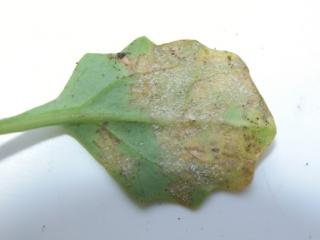Canola downy mildew is widespread
Canola downy mildew appears to be widespread this season with recent sightings at;
- Wagin
- Cunderdin
- Collie
- Kojonup
- Katanning
- Williams
- Kendenup
- South Stirling


David Peake (Bayer Crop Science) reports that downy mildew is affecting some canola crops in Wagin and Kojonup.
James Easton (CSBP) reports finding downy mildew in a canola crop near Cunderdin. The plants were at the 4-5 leaf stage with the bottom two leaves showing symptoms.
Nathan Moyes (MoyesAgri) broadly reports finding downy mildew in canola anywhere in the great southern and central wheatbelt where there has been no or poor fungicidal seed coverage in paddocks. This area includes Collie and Kojonup.
Agriculture and food plant pathologist Ravjit Khangura has observed downy mildew in several crops in the Great Southern region, including Kendenup and South Stirling.
Ravjit says that the disease mainly affects young cotyledons, true leaves and expanded leaves, however the latter are usually less severely affected.
Symptoms of downy mildew typically appear as yellowed cotyledons and lower leaves. Older leaves display angular yellow lesions on the upper leaf surface. Sometimes the lesions appear as creamish, circular to irregular spots of varying sizes on the upper leaf surface that turn brownish over time. Examination of the underside of these leaves often shows a corresponding patch of white fluffy growth, although this can become less apparent with age. Severely affected cotyledons shrivel up and senesce prematurely.
While some early seedling mortality may occur, canola plants usually overcome the disease once they reach the cabbage stage. Infected plants will exhibit slower growth earlier in the season due to a combination of cold weather and presence of disease. Plants grow away from disease as they get older and as the weather warms up during spring.
Disease is generally favoured by cool wet conditions coupled with high humidity. However, this season despite dry conditions downy mildew pathogen appear to be more aggressive than previous years. This is probably due to milder temperatures.
Downy mildew is either soil borne, seed borne or requires a green bridge for carry over. Disease epidemics are sporadic, therefore developing control strategies against downy mildew can be very challenging.
Most of the current canola varieties are susceptible to downy mildew.
Only one copper based fungicide (Cung Fu 350SC®) is registered for downy mildew in canola and needs to be applied as per product label. Ravjit says her previous research on fungicidal control of downy mildew has shown that foliar fungicides are usually effective against downy mildew if applied before the onset of the disease. The economic benefit is unlikely if sprayed after severe infection. Fungicide seed dressings containing metalaxyl (MaximXL®) may provide some protection against downy mildew if the disease pressure is low to moderate.
More information about this disease can be found at the department’s Diagnosing downy mildew in canola page.
For more information contact Ravjit Khangura, Research Officer, South Perth on +61 (0)8 9368 3374.
